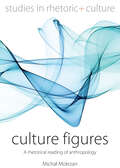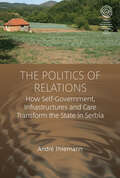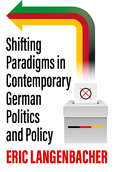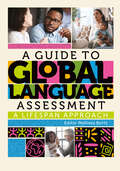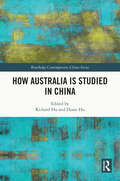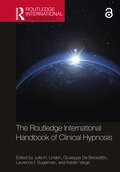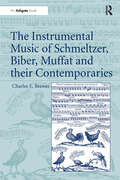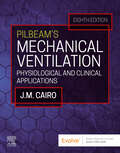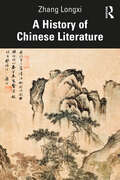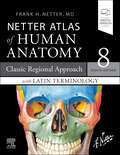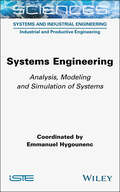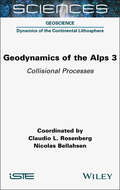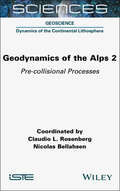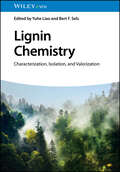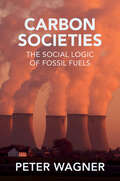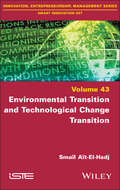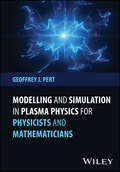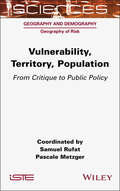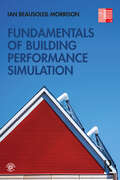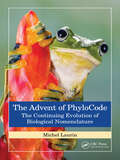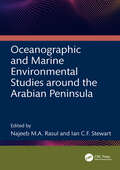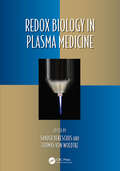- Table View
- List View
Culture Figures: A Rhetorical Reading of Anthropology (Studies in Rhetoric and Culture #10)
by Michał MokrzanEthnographic research, anthropological theory, and the understanding of the objects of inquiry, are co-created through figuration (using tropes and rhetorical figures) and techniques of persuasion. Delving into descriptive ethnography and theoretical texts spanning across classical monographs and recent texts in cultural anthropology, Culture Figures places rhetoric and rhetoricity as central to the discipline’s self-understanding. It focuses on how understandings of ‘culture’ and social life are shaped and conveyed in cultural anthropology through textual rhetoric. The book demonstrates how processes of using tropes and modes of persuasion underlie the creation of meanings or misunderstandings in society.
The Politics of Relations: How Self-Government, Infrastructures, and Care Transform the State in Serbia (EASA Series #49)
by André ThiemannRethinking the contributions of the Manchester School of Social Anthropology for political ethnography, the Politics of Relations elaborates its relational approach to the state along four interlaced axes of research – embeddedness, boundary work, modalities and strategic selectivity – that enable thick comparisons across spatio-temporal scales of power. In Serbia local experiences of self-government, infrastructure and care motivate its citizens to “become the state” while cursing it heartily. While both officials and citizens strive for a state that enables a “normal life,” they navigate the increasingly illiberal politics enacted by national parties and which are tolerated by trans-national donors.
Shifting Paradigms in Contemporary German Politics and Policy
by Eric LangenbacherGermany has undergone more change in the past two years than it has experienced in decades. In the fall of 2021, the Social Democratic Party unexpectedly surged to first place in the Bundestag elections, going on to lead a coalition of SPD, Greens, and Free Democrats that promised to “dare more progress” domestically. Then just two months after the new government was installed, Russia invaded Ukraine. The contributions in this volume investigate the altered state of German politics and predict the trajectory of Europe’s leading power in the transformed geopolitical environment.
The Politics of Relations: How Self-Government, Infrastructures, and Care Transform the State in Serbia (EASA Series #49)
by André ThiemannRethinking the contributions of the Manchester School of Social Anthropology for political ethnography, the Politics of Relations elaborates its relational approach to the state along four interlaced axes of research – embeddedness, boundary work, modalities and strategic selectivity – that enable thick comparisons across spatio-temporal scales of power. In Serbia local experiences of self-government, infrastructure and care motivate its citizens to “become the state” while cursing it heartily. While both officials and citizens strive for a state that enables a “normal life,” they navigate the increasingly illiberal politics enacted by national parties and which are tolerated by trans-national donors.
A Guide to Global Language Assessment: A Lifespan Approach
by Mellissa BortzFor decades, the speech-language therapy profession has expressed the need for the development of language assessment materials in languages other than English for children and adults. A Guide to Global Language Assessment: A Lifespan Approach aims to meet this need by providing comprehensive information about how to assess the language of bi- and multilingual and culturally diverse clients across the world.Featuring the viewpoints of contributors from around the world, A Guide to Global Language Assessment also boasts a complete database of available global language assessments.What’s included in A Guide to Global Language Assessment: Case studies, assessment frameworks, and resources for conducting global language assessments for culturally and linguistically diverse populations An array of language assessment methods across a continuum such as ethnographic and dynamic assessments, narratives, and standardized language assessment Methods for developing local norms A Guide to Global Language Assessment: A Lifespan Approach is an essential tool for empowering current and future speech-language therapists, professors, and researchers to address global language assessment across the lifespan.
How Australia is Studied in China (ISSN)
by Richard Hu Diane HuChina has arguably the largest community of Australian studies in the world. However, not much is known about this phenomenon, including its emergence, rationale, interests, influences, and the implications for strategic Australia-China engagement in a region of increasing challenge and uncertainty. This volume unpacks how Australia is taught, learnt, researched, communicated, and promoted in the Asian giant as well as its largest trade partner. In doing so, it penetrates the representation and essence of this phenomenon to seek both the ‘Australianness’ and the ‘Chineseness’ in it.This volume collects contributions from a group of leading and emerging Chinese and Australian scholars—who are members and insiders of this community—to jointly debate on this intellectual entity and its significant influences and implications. Produced at a critical moment of commemorating half a century of China-Australia diplomatic relations and four decades of formalised Australian studies in China, this volume provides an up-to-date, comprehensive, and insightful examination of this Australia-China engagement.It will be of interest to scholars, students, policymakers, and general readers in areas of Australian studies, Chinese studies, Asia-Pacific studies, China-Australia relations, and international relations.
The Routledge International Handbook of Clinical Hypnosis (Routledge International Handbooks)
by Laurence I. Sugarman Julie H. Linden Giuseppe De Benedittis Katalin VargaThe Routledge International Handbook of Clinical Hypnosis explores and clarifies the challenge of defining what hypnosis is and how best to integrate it into treatment.It contains state-of-the-art neuroscience, cutting-edge practice, and future-oriented visions of clinical hypnosis integrated into all aspects of health and clinical care. Chapters gather current research, theories, and applications in order to view clinical hypnosis through the lens of neurobiological plasticity and reveal the central role of hypnosis in health care. This handbook catalogs the utility of clinical hypnosis as a biopsychosocial intervention amid a broad range of treatment modalities and contexts. It features contributions from esteemed international contributors, covering topics such as self-hypnosis, key theories of hypnosis, hypnosis and trauma, hypnosis and chronic pain management, attachment, and more.This handbook is essential for researchers, clinicians, and newcomers to clinical hypnosis, in medical schools, hospitals, and other healthcare settings.Chapters 4, 35, 62 and 63 of this book are freely available as a downloadable Open Access PDF at http://www.taylorfrancis.com under a Creative Commons Attribution-Non Commercial-No Derivatives (CC-BY-NC-ND) 4.0 license.
The Instrumental Music of Schmeltzer, Biber, Muffat and their Contemporaries
by Charles E. BrewerBased on primary sources, many of which have never been published or examined in detail, this book examines the music of the late seventeenth-century composers, Biber, Schmeltzer and Muffat, and the compositions preserved in the extensive Moravian archives in Kromeriz. These works have never before been fully examined in the cultural and conceptual contexts of their time. Charles E. Brewer sets these composers and their music within a framework that first examines the basic Baroque concepts of instrumental style, and then provides a context for the specific works. The dances of Schmeltzer, for example, functioned both as incidental music in Viennese operas and as music for elaborate court pantomimes and balls. These same cultural practices also account for some of Biber's most programmatic music, which accompanied similar entertainments in Kromeriz and Salzburg. The many sonatas by these composers have also been misunderstood by not being placed in a context where it was normal to be entertained in church and edified in court. Many of the works discussed here remain unpublished but have, in recent years, been recorded. This book enhances our understanding and appreciation of these recordings by providing an analysis of the context in which the works were first performed.
Pilbeam's Mechanical Ventilation - E-Book: Physiological and Clinical Applications
by James M. CairoUPDATED! Revised content throughout reflects the latest standards of respiratory care.
A History of Chinese Literature
by Zhang LongxiZhang Longxi, an internationally renowned scholar of Chinese and comparative literature, is your guide to the three-millennia-long history of Chinese literature from the remote antiquity of oracle bones to contemporary works. Professor Zhang charts the development of the major literary forms in Chinese, including poetry, prose, song lyrics, and plays, and introduces the most famous poets and writers and their representative texts. Taking a period-based approach through the major dynasties, he places these forms, texts, and authors within their historical contexts and tells the fascinating story of Chinese literature with copious examples in English translation. He writes in a clear and accessible style and assumes no prior knowledge of Chinese history or Chinese literature. This book is an ideal introduction for students and the general readers who want to get a broad but thorough overview of Chinese literature in all its richness and diversity.
A Guide to Global Language Assessment: A Lifespan Approach
For decades, the speech-language therapy profession has expressed the need for the development of language assessment materials in languages other than English for children and adults. A Guide to Global Language Assessment: A Lifespan Approach aims to meet this need by providing comprehensive information about how to assess the language of bi- and multilingual and culturally diverse clients across the world.Featuring the viewpoints of contributors from around the world, A Guide to Global Language Assessment also boasts a complete database of available global language assessments.What’s included in A Guide to Global Language Assessment: Case studies, assessment frameworks, and resources for conducting global language assessments for culturally and linguistically diverse populations An array of language assessment methods across a continuum such as ethnographic and dynamic assessments, narratives, and standardized language assessment Methods for developing local norms A Guide to Global Language Assessment: A Lifespan Approach is an essential tool for empowering current and future speech-language therapists, professors, and researchers to address global language assessment across the lifespan.
Netter Atlas of Human Anatomy: paperback + eBook (Netter Basic Science)
by Frank H. NetterThis is the Latin terminology edition. For students and clinical professionals who are learning anatomy, participating in a dissection lab, sharing anatomy knowledge with patients, or refreshing their anatomy knowledge, the Netter Atlas of Human Anatomy illustrates the body, region by region, in clear, brilliant detail from a clinician’s perspective. Unique among anatomy atlases, it contains illustrations that emphasize anatomic relationships that are most important to the clinician in training and practice. Illustrated by clinicians, for clinicians, it contains more than 550 exquisite plates plus dozens of carefully selected radiologic images for common views.Presents world-renowned, superbly clear views of the human body from a clinical perspective, with paintings by Dr. Frank Netter as well as Dr. Carlos A. G. Machado, one of today’s foremost medical illustrators.Content guided by expert anatomists and educators: R. Shane Tubbs, Paul E. Neumann, Jennifer K. Brueckner-Collins, Martha Johnson Gdowski, Virginia T. Lyons, Peter J. Ward, Todd M. Hoagland, Brion Benninger, and an international Advisory Board.Offers region-by-region coverage, including muscle table appendices at the end of each section and quick reference notes on structures with high clinical significance in common clinical scenarios.Contains new illustrations by Dr. Machado including clinically important or difficult to understand areas such as the Cavitas pelvis, Fossa temporalis and Fossa infratemporalis, Conchae nasi, and more.Features new nerve tables devoted to the Nervi craniales, Plexus cervicalis, Plexus brachialis, and Plexus lumbosacralis.Uses updated terminology based on the international anatomic standard, Terminologia Anatomica, with common clinical eponyms included.Enhanced eBook version included with purchase. Your enhanced eBook allows you to access all of the text, figures, and references from the book on a variety of devices.Provides access to extensive digital content: every plate in the Atlas?and over 100 bonus plates including illustrations from previous editions?is enhanced with an interactive label quiz option. Also available: • Netter Atlas of Human Anatomy: Classic Regional Approach -With US English terminology. • Netter Atlas of Human Anatomy: A Systems Approach—With US English terminology. Same content as the classic regional approach, but organized by body system. All options contain the same table material and 550+ illustrated plates painted by clinician artists, Frank H. Netter, MD, and Carlos Machado, MD.
Systems Engineering: Analysis, Modeling and Simulation of Systems
by Emmanuel HygounencThis book is intended for students, teachers, researchers, engineers and project managers wishing to understand and implement systems engineering into their work. Based on numerous bibliographical sources, it provides coherent and accessible information, complemented with numerous illustrations. Systems Engineering will enable the reader to not only understand but also master the development cycle of a system, as well as gain an in-depth understanding of the associated terminology. An introduction to systems theory is presented first, clarifying what is meant by a complex system. The book then outlines systems engineering and one of its components: requirements engineering. A detailed presentation of the downhill activities of the development cycle follows the definition of requirements and the design of systems. Finally, the book explores the upstream activities of the development cycle with the virtual and concrete integration of the system.
Geodynamics of the Alps 3: Collisional Processes
by Claudio L. Rosenberg Nicolas BellahsenGeodynamics of the Alps consists of three volumes. This third volume is entirely dedicated to Alpine collision. It describes and interprets elements of the Alpine chain, including Alpine magmatism, the formation of external massifs, the foreland basin, the exhumation of the internal part of the chain and the northern deformation front of the Alps. The aim of this book is to create a space for experts on Alpine research to present the state of the art of specific subjects and provide their own interpretations.
Geodynamics of the Alps 2: Pre-collisional Processes
by Claudio L. Rosenberg Nicolas BellahsenGeodynamics of the Alps consists of three volumes. This second volume presents the pre-collisional history of the Alps. It discusses the Variscan orogeny in the Alpine realm, the inferred paleo-geography, the structure and processes affecting continental margins and the mantle structure in the pre-orogenic Alpine realm. It concludes by describing oceanic and continental subduction processes. The aim of this book is to create a space for experts on Alpine research to present the state of the art of specific subjects and provide their own interpretations.
Lignin Chemistry: Characterization, Isolation, and Valorization
by Bert F. Sels Yuhe LiaoLignin Chemistry A thorough reference guide to Lignin Chemistry, from inherent structure revealing to transformation into chemicals, fuels, and materials Climate change, driven by rising greenhouse gas emissions, is the defining challenge of our time. Reducing our dependence on non-renewable resources such as fossil fuels will require alternative, more sustainable resources. Lignin, the only widely-occurring, renewable, aromatic bio-polymer in Nature, has a range of application potential in the production of chemicals, fuels, and other industrial materials. Lignin science has become one of the fastest-growing and most significant areas of sustainable chemistry in the world. Lignin Chemistry: Characterization, Isolation, and Valorization presents a systematic, multidisciplinary overview of this cutting-edge field and its current state of research. Beginning with a robust characterization of lignin, the book addresses the isolation and transformation of lignin, as well as the book inspires with a plethora of applications. The result is a critical resource for researchers and professionals in any area of academic or industry where renewable biomass, in particular lignin, has importance. Lignin Chemistry readers will find: Thermochemical and catalytic strategies for lignin conversionDetailed discussion of the valorization of lignin towards biopolymers, nanoparticles, carbon fibers and materials, and hydrogelsAn authorial team with immense and varied research experience Lignin Chemistry is ideal for chemical engineers, catalytic chemists, biochemists, material scientists, and analytical chemists in industry.
Carbon Societies: The Social Logic of Fossil Fuels
by Peter WagnerThe climate crisis is humanmade. Its main cause is the burning of fossil fuels. To combat climate change, we have to understand how we arrived at where we are. This book explores the reasons why human societies have embarked on the trajectory of ever-increasing use of fossil fuels.Population growth, desire for freedom from want and profit-seeking all played major roles in shaping human history, but there has been no inevitable drive towards heating up the atmosphere in the pursuit of social objectives. To sustain a growing population, more natural resources are required, but their use does not need to generate climate change. No logic of modernity links freedom with a kind of material abundance that requires the burning of fossil fuels. No logic of capital necessarily ties the search for profit to the extraction of fossil resources.Examining the critical junctures in human history when resource regimes changed, this book identifies the social problems that were meant to be solved by burning fossil fuels and the power hierarchies that shaped the decisions to use them. Wagner argues that the key choices that led to the climate emergency were made relatively recently, during the second half of the 20th century: they are close enough in time for us to undo the prevailing social logic of fossil fuels. By redefining the key problems that humankind is facing and reshaping the existing mechanisms of power, we can take the decisive action needed to reduce our dependence on fossil fuels and avert the worst consequences of climate change.
Environmental Transition and Technological Change Transition
by Smaïl Aït-El-HadjFaced with the scale and intensity of the ecological crisis, environmental transition is underway, consisting of a first phase of technological mutation, aimed at replacing technologies harmful to the environment with those which have no destructive effects on the earth system and its equilibrium. This book examines the roots of the concept of environmental transition, identifying and characterizing the negative effects of technology on the environmental crisis. We will then identify the technological mutations that have the potential to contribute to environmental transition, and demonstrate how these changes are already forming part of a new emerging "technological system". We will conclude by addressing the question of the limits of technological responses to the environmental crisis, demonstrating the importance of the dimensional factors of human activity and weight of growth in this crisis, thus raising the issue of global reconsideration, with reference to the place and articulation of human activity in the Earth system.
Modelling and Simulation in Plasma Physics for Physicists and Mathematicians
by Geoffrey J. PertUnveiling the Secrets of Plasma Physics: A Practical Guide to Computational Simulations Plasma physics focuses on the most abundant state of matter in the universe, corresponding to ionized gas comprising ions and electrons. It can be created artificially and has a huge range of technological applications, from television displays to fusion energy research. Every application of plasma technology requires its own numerical solution to the complex physical and mathematical equations which govern the research field of plasma physics. Modelling and Simulation in Plasma Physics for Physicists and Mathematics offers an introduction to the principles of simulating plasma physics applications. It provides knowledge not only of the fundamental algorithms in computational fluid mechanics, but also their specific role in a plasma physics context. In addition, the book dissects the challenges and advancements, unveiling the delicate balance between accuracy and computational cost. Modelling and Simulation in Plasma Physics for Physicists and Mathematics readers will also find: Cutting-edge computational insights where powerful simulations meet theoretical complexities, providing physicists and mathematicians a gateway to cutting-edge research. An overview of programming language-agnostic code generation and the construction of adaptable models that resonate with the intricate dynamics of plasma physics, ensuring precision in every simulation. Advanced simplification strategies, including time splitting, analytic models, averaged rates, and tabular material, offering scientists and engineers a roadmap to balance computational demands with scientific rigor. Modelling and Simulation in Plasma Physics for Physicists and Mathematics is ideal for plasma physicists, students, and engineers looking to work with plasma technologies.
Vulnerability, Territory, Population: From Critique to Public Policy
by Samuel Rufat Pascale MetzgerDuring the Covid-19 pandemic, the term "vulnerable" was applied to "individuals" and to "populations", "groups" and "countries" in discussions, laws and regulations; now it applies to all objects in relation to all kinds of threats. However, rather than a label for governing people and places, the notion of "vulnerability" was expected to become an instrument to tackle the root causes of disasters, poverty and maldevelopment, as well as the inequalities and injustices they bring, whether social, political, economic or environmental. Despite this radical dimension, vulnerability has gradually been incorporated into public policies and international recommendations for global risk and disaster management. This book is intended for researchers, students, managers and decision makers concerned with the management of not only risks and crises but also climate and environmental change. The first part examines the multiple theoretical and conceptual approaches; the second explores vulnerability assessments, using examples from the Global North and Global South; and the third discusses tools, public policies and actions taken to reduce vulnerability.
Fundamentals of Building Performance Simulation
by Ian Beausoleil-MorrisonFundamentals of Building Performance Simulation pares the theory and practice of a multi-disciplinary field to the essentials for classroom learning and real-world applications. Authored by a veteran educator and researcher, this textbook equips graduate students and emerging and established professionals in engineering and architecture to predict and optimize buildings’ energy use. It employs an innovative pedagogical approach, introducing new concepts and skills through previously mastered ones and deepening understanding of familiar themes by means of new material. Covering topics from indoor airflow to the effects of the weather, the book’s 19 chapters empower learners to: Understand the models and assumptions underlying popular BPS tools Compare models, simulations, and modelling tools and make appropriate selections Recognize the effects of modelling choices and input data on simulation predictions And more. Each subject is introduced without reference to particular modelling tools, while practice problems at the end of each chapter provide hands-on experience with the tools of the reader’s choice. Curated reading lists orient beginners in a vast, cross-disciplinary literature, and the critical thinking skills stressed throughout prepare them to make contributions of their own. Fundamentals of Building Performance Simulation provides a much-needed resource for new and aspiring members of the building science community.
The Advent of PhyloCode: The Continuing Evolution of Biological Nomenclature
by Michel LaurinBiological nomenclature is an essential tool for storing and retrieving biological information. Yet traditional nomenclature poorly reflects evolutionary theory. Current biological nomenclature is one of the few fields promoting deliberately vague usage of technical terms. A new code based on evolutionary studies and phylogenetic results (the PhyloCode) will be a major milestone in biological nomenclature. Unfortunately, The PhyloCode and the companion volume are highly technical publications intended for practicing systematists. This book will reach a broader readership of those using nomenclature but who remain unaware of its theoretical foundations.Key Features Responds to the biodiversity crisis and the recent implementation of the PhyloCode Summarizes the spectacular progress of phylogenetics which makes it both increasingly easy and crucially important to define precisely taxon names Provides a 300-year historical perspective featuring high-profile characters, such as Linnaeus and Darwin Summarizes for a broad readership a widely scattered, highly technical and underappreciated scientific literature Documents the activities of the International Society for Phylogenetic Nomenclature, a scholarly society in which the author has played a prominent role
Oceanographic and Marine Environmental Studies around the Arabian Peninsula
by Najeeb M.A. Rasul Ian C.F. StewartOceanographic and Marine Environmental Studies around the Arabian Peninsula presents studies on a range of topics related to the marine environment of the Red Sea and Arabian (Persian) Gulf. This book contains invited and peer-reviewed chapters from diverse researchers active in their respective fields. The chapters offer new data and include comprehensive lists of references. Some of the main topics included in the book are pollution from heavy metals and petroleum, hydro-environmental characteristics of the seas, conservation of marine ecosystems, the risk of climate change on the Red Sea region, and the mangrove environment. With new developments occurring in the coastal regions in recent decades, the book will be not only a helpful resource to researchers but also a valuable reference for anyone curious about managing the marine and littoral environment of these two unique seas.
Corneal Cross-Linking
by Farhad HafeziCorneal Cross-Linking, Second Edition represents an innovative approach to treating primary acquired and secondary induced ectatic disorders. In addition, corneal cross-linking (CXL) has promising applications as an alternative in the treatment of corneal infectious and non-infectious melting, as well as conditions such as Fuchs’ endothelial dystrophy.
Redox Biology in Plasma Medicine
by Thomas Von Woedtke Sander BekeschusPlasma medicine uses non-equilibrium plasmas generated under atmospheric-pressure conditions. Therapeutical plasmas can stimulate tissue regeneration or inactivate cancer cells. This book reviews the interrelation between plasma chemistry and biochemistry complemented by discussion of the ways plasmas inactivate various pathogens. Focus is on the plasma effects on mammalian cells, subsequent consequences for cell-biological processes, and plasma applicability to specific medical therapies. Contributions illustrate the ways cold atmospheric-pressure plasma can be used as a controllable source of redox-active species and as a useful tool for research in redox biology. Key Features Summarizes plasma chemistry, biochemistry, and microbiology Documents the ways plasmas interact with lipids, membranes, and cells Reviews therapeutic uses of plasmas in medicine Focuses on uses of plasmas in cancer treatment
